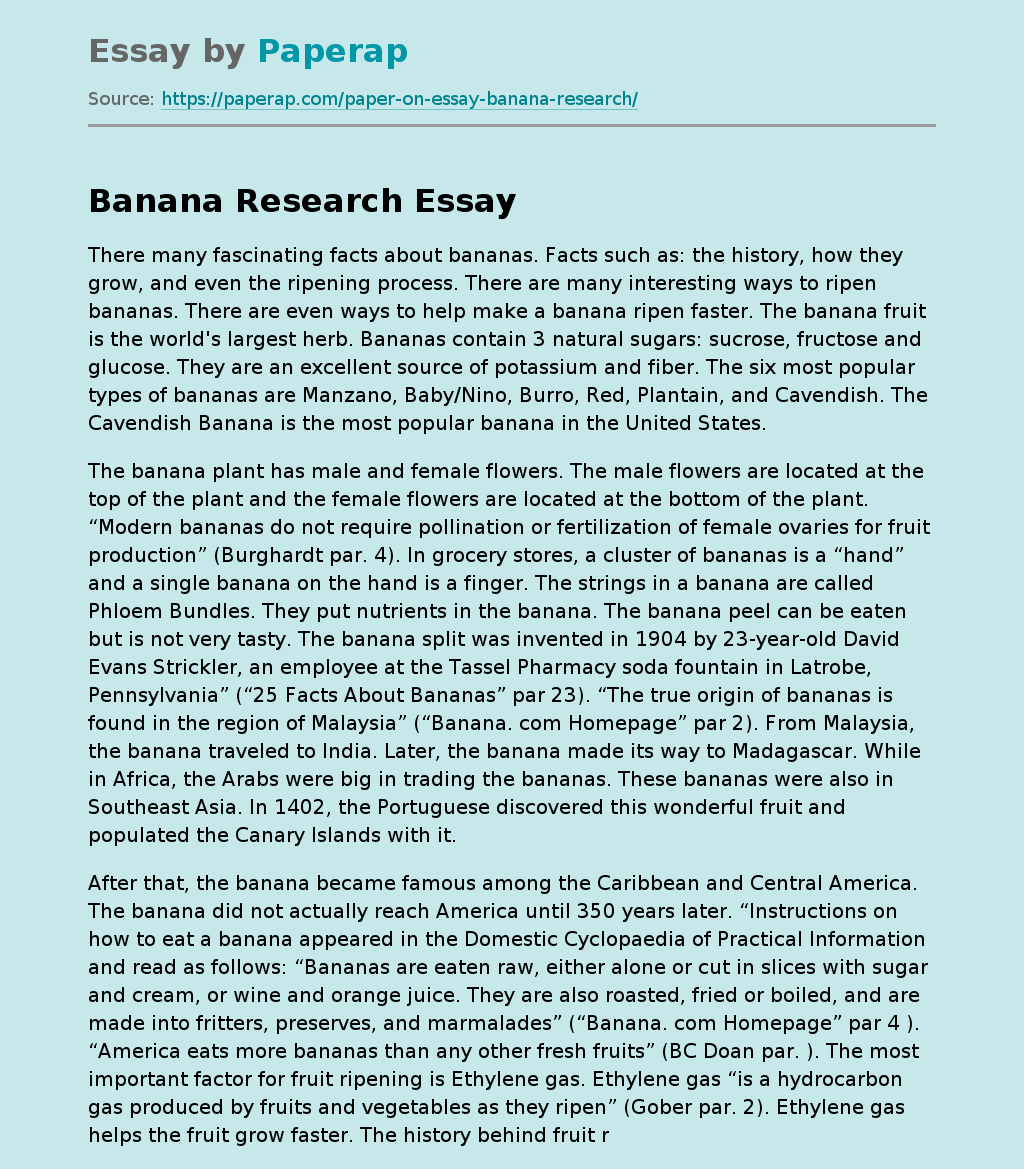Banana Research
There many fascinating facts about bananas. Facts such as: the history, how they grow, and even the ripening process. There are many interesting ways to ripen bananas. There are even ways to help make a banana ripen faster. The banana fruit is the world’s largest herb. Bananas contain 3 natural sugars: sucrose, fructose and glucose. They are an excellent source of potassium and fiber. The six most popular types of bananas are Manzano, Baby/Nino, Burro, Red, Plantain, and Cavendish. The Cavendish Banana is the most popular banana in the United States.
The banana plant has male and female flowers. The male flowers are located at the top of the plant and the female flowers are located at the bottom of the plant. “Modern bananas do not require pollination or fertilization of female ovaries for fruit production” (Burghardt par. 4). In grocery stores, a cluster of bananas is a “hand” and a single banana on the hand is a finger. The strings in a banana are called Phloem Bundles.
They put nutrients in the banana. The banana peel can be eaten but is not very tasty. The banana split was invented in 1904 by 23-year-old David Evans Strickler, an employee at the Tassel Pharmacy soda fountain in Latrobe, Pennsylvania” (“25 Facts About Bananas” par 23). “The true origin of bananas is found in the region of Malaysia” (“Banana. com Homepage” par 2). From Malaysia, the banana traveled to India. Later, the banana made its way to Madagascar. While in Africa, the Arabs were big in trading the bananas.
These bananas were also in Southeast Asia. In 1402, the Portuguese discovered this wonderful fruit and populated the Canary Islands with it.
After that, the banana became famous among the Caribbean and Central America. The banana did not actually reach America until 350 years later. “Instructions on how to eat a banana appeared in the Domestic Cyclopaedia of Practical Information and read as follows: “Bananas are eaten raw, either alone or cut in slices with sugar and cream, or wine and orange juice. They are also roasted, fried or boiled, and are made into fritters, preserves, and marmalades” (“Banana. com Homepage” par 4 ). “America eats more bananas than any other fresh fruits” (BC Doan par. ). The most important factor for fruit ripening is Ethylene gas. Ethylene gas “is a hydrocarbon gas produced by fruits and vegetables as they ripen” (Gober par. 2). Ethylene gas helps the fruit grow faster. The history behind fruit ripening is quite fascinating. Many people have tried to speed up the ethylene in the process of ripening fruit. “Throughout the years, scientists discovered that cutting open the fruit in high temperatures tends to set off the plants ethylene” (Kendrick par. 2). Which is what the ancient Egyptians and Chinese farmers used to do.
The Egyptians would slice open the fruit to speed up the ripening process. The Chinese would leave their fruit in a closed room with burning incense. Besides ethylene, there are many things in the ripening process. “Unripe fruit is often green, odorless, sour, hard and mealy. The ripening process makes the fruit more appealing, by breaking down the chlorophyll, sour acids and also converts mealy starches into sugar” (Nemec par. 3). Once the ripening process is complete, the fruit is now fresh, colorful, juicy, and ready to eat.
Warm temperatures are good for increasing the ethylene gas, in which speeds up the ripening process. Cool temperatures will slow down the process. That is why when bananas are harvested, they are quickly shipped in boxes under refrigeration in order to keep them from ripening until they reach their destination. Some interesting ways to ripen a banana is to stick it in a paper bag with a ripe apple. The ethylene from both fruits will get trapped, causing the ripening process to speed up.
Another similar way is to put the banana by itself in a paper bag. Still another fascinating way to ripen a banana is to plaster it with mud! “Bananas and pineapples rank as the best-known tropical fruits” (“Tropical Fruits” pg 546). Tropical fruits can not grow in cold weather even with the slightest of frost, they will die. Scientists are still trying to accomplish better ways of preventing fruit from ripening during long distance transportation. When a banana is fully ripe, it is yellow, delicious, and good for you. Eat more bananas!
Banana Research. (2019, Jun 20). Retrieved from https://paperap.com/paper-on-essay-banana-research/

